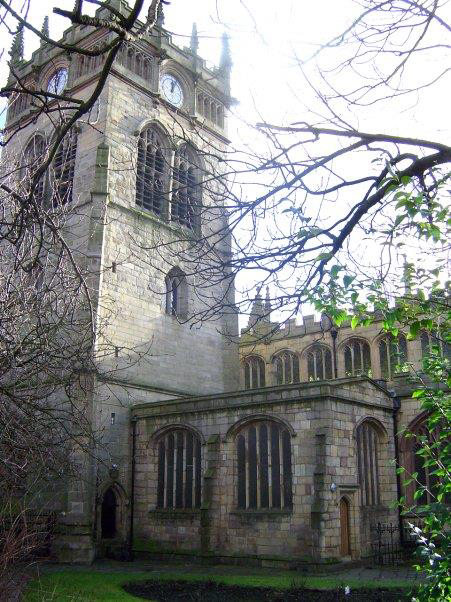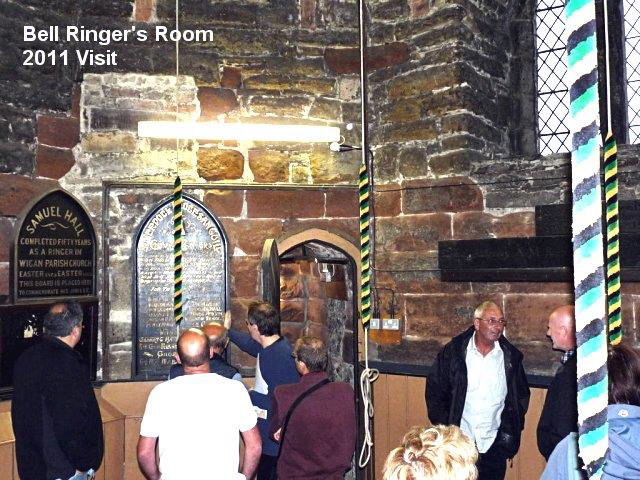
In 2011 Peter Layland presented us with a paper on the research he had carried out on the history and origins of the Wigan's All Saints Parish Church (an updated version can be viewed here). Since he retired Peter has been increasingly fascinated by the Church's tower. This is the only part, apart from the Walmesley Chapel and rood turrets, that survived rebuild of the Church in the 1840s and probably dates to the 13th century.
Peter is also intrigued by the fact that it's location with regard to the Church is not where you would normally expect, positioned as it is on the northeast side (towers are normally on the west end or in the centre if there is a transept). Last year Peter asked if we could help with a new study focusing just on the tower. We agreed and early in the New Year we started a survey of the tower to see if we could unravel some of the mysteries of this strange and intriguing structure.
We have of course made a number of visits to the tower in the past. On our first visit, in 2011, Peter gave us a guided tour which revealed to us for the first time the nature of the tower's internal structure (the exterior lower half was refaced with fine ashlar sandstone blocks in 1922). We could see quite clearly on the first floor in the Bell Ringer's Room, that the original construction was of large regular-cut red sandstone blocks. At some later date the walls had been extended using smaller rough-cut grey sandstone blocks.

In 2017 we attempted our first Historical Graffiti project (Newsletter No.200) which we never got to finish. However, the exercise did enable us to complete a more comprehensive and successful study of St Wifrid's Parish Church in Standish.
Another strange feature we spotted on our first visit was what appeared to be a guarderobe i.e. a Medieval toilet, normally only found in castles. This, together with the thickness of the walls (i.e. 2m thick) has suggested to some that the tower was originally a defensive structure. This is at odds however with the huge archway which connects the tower with the rest of the church (and there is no reference to one in the historical record). Other features of the tower on the ground floor are well known such as the Roman altar embedded in the north wall window arch. Also a Medieval grave slab embedded in the east wall (both recorded on our Artefacts and Monuments database). What has come as surprise though is the realisation that a large window also exists in the west wall of the tower. This had only come to light when the Church was rebuilt in the late 1840s (it's still blocked up on the Walmesley Chapel side).
Last week we continued our survey with a second visit. Using a variety of tools such as a laser range finder as well as tapes, we have been able to collect a range of dimensions. These will enable us to produce detailed drawings and even a 3D CAD model. Chris Drabble has also used his LiDAR device and software to produce a VR model. All of this will be a very useful contribution to Peter's research and report. More details on our blog and follow our progress on our Site Diary.
Programme for 2023
As usual at this stage it's early days. However we already have Kevin Wright from Tameside Arch Soc in March talking about their Grange Farm Mesolithic and Neolithic Project. Also in April Peter Layland will be presenting his research on the Church and its strange tower. In May Fraser Brown from Oxford Archaeology North has agreed to give us a talk on the Windy Harbour Research Project - a huge investigation carried out on the Fylde in advance of a new bypass running to the west of the River Wyre. In June we're hoping to have Alison Burns who gave a very interesting talk to the CBA NW Conference last year on her research into the Prehistoric footprints on the Formby and Sefton coastline (tbc).
Next Meeting
Wednesday 1st February - at the Real Crafty on Upper Dicconson Street starting at 7.30pm as usual. This month, as it's the first of the year, will be our AGM but, as usual, the proceedings won't take too long. After which we will be having a talk by one of our new members Brian Smith. He will be taking us on a journey through the prehistoric landscape of the Kilmartin Glen in the west of Scotland, with a look at the various sites on route. Just a reminder that, as it's our AGM, subs are due this month. Hope to see you there - BA. | 


